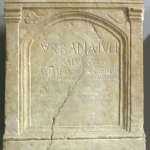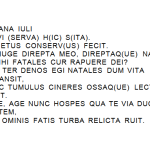Urbana’s tombstone
The tombstone was commissioned by Atimet, a slave belonging to a refined family of early colonists in Emona. Normally, only rich people could afford tombstones as they were too expensive for the common man. In light of this, the white marble tombstone you see here is quite special. Another distinction is the quality of the verses chiselled into the stone, which leads us to believe that Atimet and Urbana were educated slaves, which was rare in those times.
In the Roman Empire slaves were usually military prisoners who were used as a cheap labour force by Romans following their military conquests. Unlike Roman citizens they weren’t free and had no rights, and their fate was fully in the hands of their masters who could even murder them without consequence. In rare cases they were able to purchase their freedom, or they could be freed by their master as a reward for outstanding service. Owning slaves represented a particular prestige in Roman society as it reflected the high economic status of a family, since slaves had to be purchased on the market and also cared for which was financially demanding.





